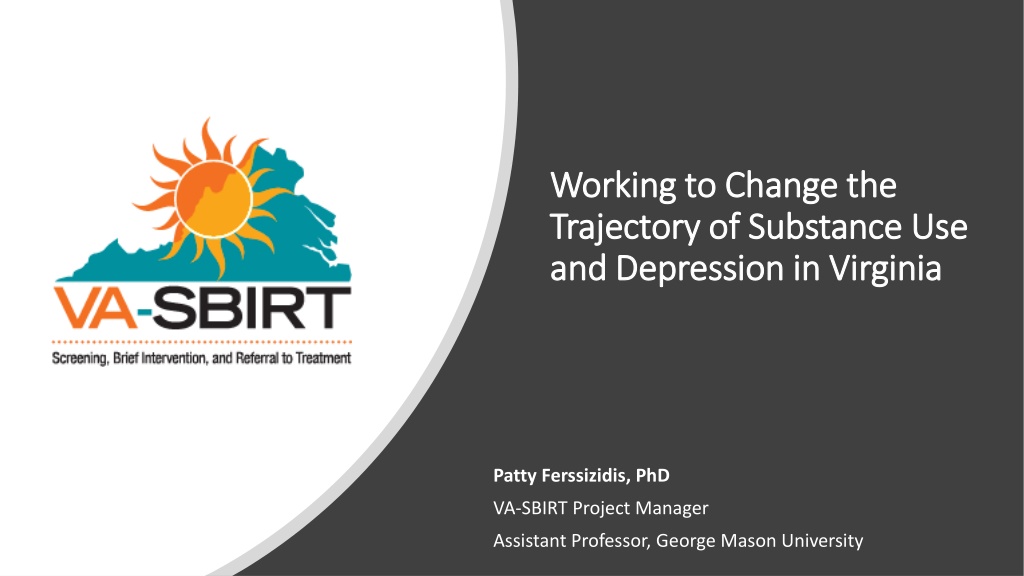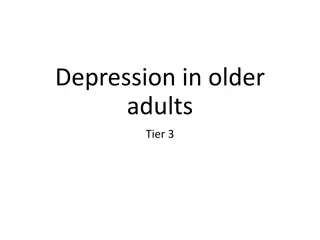Transforming Substance Use and Depression Trajectory in Virginia
Patty Ferssizidis, PhD, as the VA-SBIRT Project Manager at George Mason University, is spearheading efforts to alter the trajectory of substance use and depression in Virginia. The SBIRT model is being utilized to screen, identify, intervene, and connect individuals with substance use risks to appropriate treatment and prevention services. Brief interventions have shown to be effective in reducing alcohol misuse, as evidenced by a 40% reduction in harmful use and a 55% decrease in negative social consequences among individuals screened by SAMHSA-supported programs. This comprehensive approach aims to address service gaps and provide accessible support to those in need.
Download Presentation

Please find below an Image/Link to download the presentation.
The content on the website is provided AS IS for your information and personal use only. It may not be sold, licensed, or shared on other websites without obtaining consent from the author. Download presentation by click this link. If you encounter any issues during the download, it is possible that the publisher has removed the file from their server.
E N D
Presentation Transcript
Working to Change the Working to Change the Trajectory of Substance Use Trajectory of Substance Use and Depression in Virginia and Depression in Virginia Patty Ferssizidis, PhD VA-SBIRT Project Manager Assistant Professor, George Mason University
Describe Describe the SBIRT process. Overview Share Share outcomes to date. Discuss the role of SBIRT in a comprehensive plan for addressing addiction. Discuss
Substance Use Is A Public Health Problem
A Population-Based Response to Substance Use Where do we reach the greatest number of people? How do we identify substance risk? What do we do to intervene? When do we intervene?
Identifying a Service Gap Specialty Substance Use Treatment ??? Prevention Efforts
The SBIRT Model Brief Universal Screen Alcohol, Drugs, Tobacco, Depression Secondary Screen to stratify risk Screening IDENTIFY Brief Motivational change-based discussion Brief, 5-10 minutes INTERVENE (Mild Risk) Intervention Referral to Treatment Active and Collaborative referral practices On site outpatient therapy (MET/CBT) Specialty Treatment in the Community CONNECT (Moderate & High Risk)
Addressing a Service Gap Specialty Substance Use Treatment SBIRT Prevention Efforts
Brief interventions are feasible and Brief interventions are feasible and highly effective components of an overall highly effective components of an overall public health approach to reducing public health approach to reducing alcohol misuse. alcohol misuse. Whitlock et al., 2004, for U.S. Preventive Services Task Force
Evidentiary Support Of 1.5 million screened by SAMHSA-supported programs (SAMHSA GPRA data, 2003-2011), 40% reduction in harmful use 55% reduction in negative social consequences Positive benefits for reduced illicit substance use Reductions in other risky behaviors (injection drug use, unprotected sex) $3.81 to $5.60 for every dollar spent (Fleming et al., 2000)
VIRGINIA SCREENING, BRIEF INTERVENTION, AND REFERRAL TO TREATMENT PROJECT o $8.3 million SAMHSA grant awarded to DBHDS o Implemented by GMU o 11+ practice sites o EDs o Free Clinics o FQHCs o University Student Health Clinic o Health Departments oFamily Practice & Urgent Care Coming Soon!
SUBSTANCE RISK IN VIRGINIA 1% Severe 2% Moderate Based on Screening of 50,045 Virginians in Shenandoah Valley & Northern Virginia over a period of two years. 9% Mild 88% Within Normal Levels
When people screen positive for past year drug use, what drugs are they using? Clinic for Uninsured Emergency Dept Primary Care Practice Health Dept - STI Student Health Service Marijuana 82% 89% 91% 89% 100% Prescription Misuse 13% 25% 12% 17% 10% Other Illegal Drug Use 23% 16% 22% 26% 14%
TREATMENT ENGAGEMENT National Survey on Drug Use & Health 10.6% who needed treatment actually received it. 20% engaged in brief treatment in ED, 33% in non-ED setting 50% engaged in an assertive referral to treatment process across settings
STORIES A woman who I had met with prior, came to the clinic with her cousin. She approached me and said thank you and that our BI had changed her life. She was concerned about her cousin's alcohol use and hoped that I could meet with him as well.
STORIES I had a client drinking 7-8 beers a day that I referred to specialty care last year. He did not follow through on the referral or respond to my follow up at the time. At his rescreen a year later, I learned he had tapered his drinking down to 1-2 binges a month on his own and was also looking to quit cannabis and alcohol altogether. He has enrolled in Brief Treatment and is making progress through outpatient therapy plus SSRI medication to treat anxiety.
THANK YOU ON BEHALF OF THE VA-SBIRT TEAM Patty Ferssizidis, PhD pzorbas@gmu.edu























